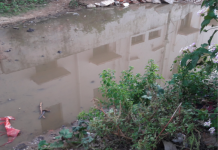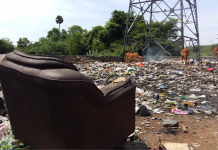Problem Statement: How Can We Prevent Animals From Entering The Siruseri Dump Yard
- Describe the past scenario
This dump yard was built around 20 years ago by the Panchayat Leader because every panchayat should have a dump yard were the corporation will collect the garbage of that panchayat and will dump it there. The dump was built with thick wall surrounding it and 1 gate for entering and leaving. What were the factors that eroded a huge chunk of the wall? Why did animals go in there rather than go in the forest in search of food? Why didn’t the Panchayat take steps to maintain the dump yard? Why did they build the dump yard far away from where the people live?
- Describe the present scenario
Currently the dump yard is often visited by cows and crows. I don’t think much has changed about the method they use to get rid of the waste hence pollution is cause when the waste is burned. Animals and crows die as the plastic material can’t be digested easily and no steps are taken to solve this issue. Also the corporation truck comes twice daily to dump the waste and the previous waste needs to get rid before the waste comes so lot of pollutants are dispersed. There are many items in the dump yard that could have easily been recycled. How can we convince the Panchayat to help in fixing the issue? How can we educate people to follow Reduce, Reuse, Recycle and Waste Segregation? What can we do to make sure the animals don’t enter the dump yard? Why didn’t the Panchayat even notice these problems?
- Imagine and describe how the future will be?
The dump yard, the walls and the gate surrounding it should be maintained so that animals can’t enter the dump yard in search of food. The corporation and the people living should strictly follow Waste Segregation so that the actual waste that is dumped will reduce massively and the classified waste can be used for other useful purposes. The other half of the dump yard can be used for composting. What factors may affect the durability of the walls and the gate? How can we educate rural people to believe in waste segregation? What can we do if some of them don’t cooperate and throw the wrong thrash in the wrong bin? Will all the Panchayat Leaders henceforth will continue the effort or just repeal it? What constrains will we face when implementing the solutions?
- Find out various stakeholders in your social problem
Waste Segregation, People’s Cooperation, Weather, Panchayat, Management, Corporation.
- Put parallels of your story with other countries
Waste is costly. The earth is a closed system. Any nutrients and resources being taken out of the system (and buried in a landfill, or burnt) are resources lost to us. Aesthetically, waste causes various forms of pollution, from land to water pollution, to blocked drains caused by littering. The waste we put out in bins from our homes each week is really just the tip of the iceberg.
Most of the countries of the world are struggling to deal with their waste problems. Poor management of waste impacts on the public health of entire communities and cities; pollutes local water, air and land resources; contributes to climate change and ocean plastic pollution; aids climate change and hastens the depletion of forests and mines.
Solid waste management until now has only been a social responsibility of the corporate world or one of the services to be provided by the municipality and a non-priority for national governments. However, in Mumbai, the improperly managed wastes generate 22,000 tons of toxic pollutants like particulate matter, carbon monoxide, nitrous and sulfur oxides in addition to 10,000 grams of carcinogenic dioxins and furans every year. These numbers are only for the city of Mumbai. This is the case in cities all across the developing world. There are numerous examples where groundwater is polluted by heavy metals and organic contaminants due to solid waste landfills.
Solid waste management expenditure of above $1 billion per year competes with education, poverty, security and other sustainable initiatives in New York City. Fossil fuels for above 500,000 truck trips covering hundreds of miles are required to transport NYC’s waste to landfills outside the city and state. Similarly, New Delhi spends more than half of its entire municipal budget on solid waste management, while it is desperate for investments and maintenance of roads, buildings, and other infrastructure. (Credit to SALMAN ZAFAR for this article)
Landfills such as Bordo Poniente in Mexico City, Mexico, Laogang in Shanghai, China, and Jardim Gramacho in Rio de Janiero, Brazil, each receive more than 10,000 tonnes of waste per day. In China, expanding cities are adding incinerators which are in turn adding to air pollution.
As the world hurtles toward its urban future, the amount of municipal solid waste (MSW), one of the most important by-products of an urban lifestyle, is growing even faster than the rate of urbanization. Ten years ago there were 2.9 billion urban residents who generated about 0.64 kg of MSW per person per day (0.68 billion tonnes per year).
Experts estimate that today these amounts have increased to about 3 billion residents generating 1.2 kg per person per day (1.3 billion tonnes per year). By 2025 this will likely increase to 4.3 billion urban residents generating about 1.42 kg/capita/day of municipal solid waste (2.2 billion tonnes per year).
We have to figure out how to work together as a planet to bring this amount of solid waste down.
We need to find ways within our already existing urban centres – through manufacturers, consumers and government – to reduce solid waste. Until we do, the waste will continue to mount, creating greenhouse gas emissions and pollution from ash which all impacts on our landscape and biodiversity.
But we do already have a Solution!
Given that the world also has a growing energy problem, and the fact that we do have the Technology available to turn waste into energy whilst actually producing no toxic emissions, isn’t the solution staring us in the face?
Energy recovery from problematic Municipal Solid Waste (MSW) can assuage significant portion of a city’s energy requirement whilst at the same time eliminating the problem of waste disposal. Reducing landfills will reduce ground and surface water pollution which can also help provide cleaner drinking water.
Additionally, a good solid waste management plan with cost recovery mechanisms can free tax payer’s money for other uses. In the case of India, sustainable solid waste management in 2011 would have provided
- 6 million tons of compost that could have resulted in a better agricultural yield
- energy equivalent to 58 million barrels of oil from non-recyclable wastes
- 7 million tons of secondary raw materials to industries in the form of recyclable materials and livelihood to the urban poor
Waste-To-Energy Power
Conversion of waste to energy is an extremely valid and viable route for managing waste and utilizing its products.
An effective Utag Plasma Gasification WTE plant should be able to generate a number of revenue streams: gate fees for the waste it receives, generated electricity which is sold to the local grid on long-term power purchase agreements, and potential revenue from the sale of recyclables removed or the sale of heat to co-located industries. This approach is of growing interest to the major European energy providers, who must boost their renewable electricity output 15%-20% to meet the targets. With commercial waste predicted to increase by 50% by 2020, the ability to build small plants in industrial areas could transform the energy landscape with local waste being used to produce local electricity.
Here we list just 10 benefits. (Credit to Melting Coal)
- Production and use of energy: Electricity and heat can be generated from waste which provide an alternative and more environment-friendly source of energy
- Reduction of waste going to landfill: Waste that would have normally gone to landfills is diverted to an energy processing unit thereby saving valuable land. A Plasma Power Plant can also utilise existing landfill content as a feedstock, thus cleaning up previously toxic sites and enabling them to be sold for other uses such as development.
- Avoidance of disposal costs and landfill taxes: The cost associated with the transport of wastes to landfill is reduced and also landfill taxes imposed by governing bodies are avoided.
- Use of by-products as fertilizers: The by-product of some waste to energy processes such as anaerobic digestion can be used as fertilizers and improves the nutrient content of soil.
- Avoid methane emissions from landfills: When waste is delivered to a waste to energy facility, the methane that would have been generated if it were sent to a landfill is avoided
- Reduction in carbon emitted: On generating energy from waste, the carbon emission that would have been generated from a fossil fuel source is avoided.
- Reduction of reliance on fossil fuel: Fluctuations in oil prices and rising costs can be avoided. Waste to energy does not rely on fossil fuel hence the dependence on oil reduced.
- Domestic production of energy: Plenty of waste is generated locally and hence there is no requirement of transportation of materials or this process from far out.
- Benefit to the local community and economy: As waste to energy plants are generally setup locally it creates jobs, the local community benefits and materials are sourced locally.
- Stability in availability of energy and its price: Using of waste to generate electricity can help reduce fluctuations of price. Also, there are no wide fluctuations and shortages in availability.
What about Recycling?
Many suggest that recycling of waste, while possibly an important interim measure, is simply being less bad, or trying to make a bad system more efficient. Recycling offers the recapture of small amounts of smashed up materials. It is inefficient and difficult as the products are not designed for reuse. The best that recycling has to offer is the destruction of products after one use (through smashing, chopping, grinding, etc. at a notable cost in resources, particularly water and energy) and laborious recapture of only the bare materials.
http://www.utagtechnology.com/how-can-we-solve-our-waste-and-landfill-problems/






